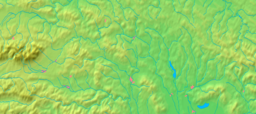Podolínec
| Podolínec | |
| Town | |
|
A church in Podolínec
|
|
| Country | Slovakia |
|---|---|
| Region | Prešov |
| District | Stará Ľubovňa |
| Tourism region | Spiš |
| River | Poprad |
| Elevation | 572 m (1,877 ft) |
| Coordinates | 49°15′26″N 20°31′51″E / 49.25722°N 20.53083°ECoordinates: 49°15′26″N 20°31′51″E / 49.25722°N 20.53083°E |
| Area | 33.183 km2 (12.812 sq mi) |
| Population | 3,204 (31 December 2005) |
| Density | 97/km2 (251/sq mi) |
| First mentioned | 1235 |
| Mayor | Iveta Bachledová |
| Timezone | CET (UTC+1) |
| - summer (DST) | CEST (UTC+2) |
| Postal code | 065 03 |
| Area code | +421-52 |
| Car plate | SL |
| Statistics: MOŠ/MIS | |
| Website: www.podolinec.eu | |
Podolínec (Polish: Podoliniec, German: Pudlein, Hungarian: Podolin) is a town in the Stará Ľubovňa District of the Prešov Region in northern Slovakia.
The etymology is straightforward, the name means in Slovak "place between the hills".
Originally Podoliniec belonged to Poland and was part of the Ziema Sądecka land. The first written record of Podolínec dates from 1235 and is included in the Kraków Bishop complaint to the Pope regarding the Hungarian clergy, illegally collecting taxes from the local church, which belonged to the Diocese of Kraków. In 1244 Bolesław V the Chaste, the Dux of Sandomierz-Kraków land granted a location permit to a knight from Kraków, called Henryk. In 1292 the place was given the city rights. Later in the second half of the 14th century, the town passed in the reign of Hungary. In April 1412, King Sigismund of Luxembourg promoted Podolínec to the status of a free royal town, but later that year it was granted back to Poland as a result of the Treaty of Lubowla and it remained Polish until 1772. There was a Piarists' Collegium, founded by the Starosta (lat. Capitaneus) of Spisz, Stanisław Lubomirski. The most famous ward of the Collegium was Stanisław Konarski who joined the Piarist Order in 1715. Podolínec was at that time a walled town with its own castle. It was the only town in the Spiš region to resist the Hussite raids. Following the First Partition of Poland in 1772, the grant was cancelled in 1773 and the town was re-incorporated into the Kingdom of Hungary three years later. It was part of the "Province of 16 Spiš towns" in the 18th and 19th centuries, but its privileges were gradually reduced and in the end it was incorporated into Szepes county. The industrial revolution bypassed Podolínec and the railway came to the town only in 1893, when some small industrial production developed. After the Treaty of Trianon in 1920, Podolínec became part of Czechoslovakia.
...
Wikipedia





